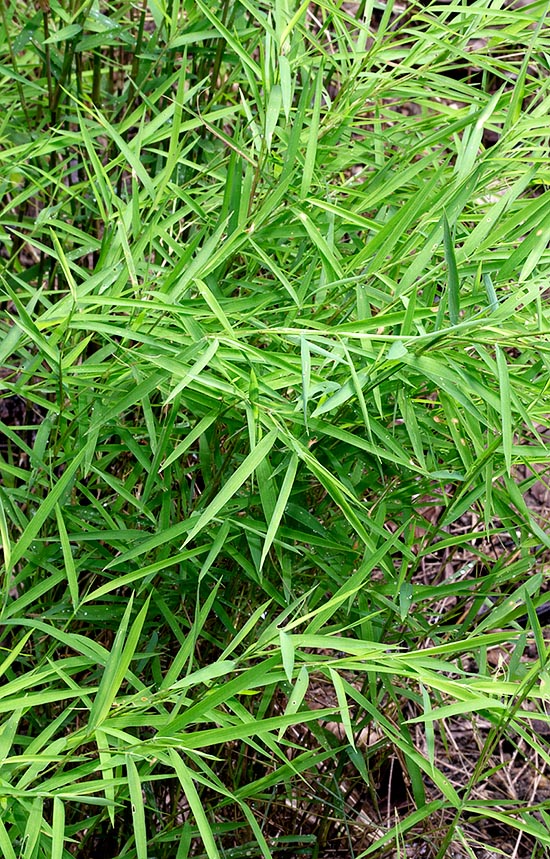Family : Poaceae

Text © Pietro Puccio

English translation by Mario Beltramini

Pogonatherum crinitum is a south-eastern Asia perennial herbaceous similar to a small bamboo. Fresh or dried is used in the traditional medicine for various pathologies © Giuseppe Mazza
The species is native to Andaman Islands, Assam, Bangladesh, Cambodia, China (Anhui, Chongqing, Fujian,Guangdong, Guangxi, Guizhou, Hainan, Henan, Hong Kong, Hubei, Hunan, Jiangsu, Jiangxi, Kin-men, Macao, Ma-tsu-Pai-chúan, Shangai, Sichuan, Yunnan and Zhejiang), Eastern Himalaya, India, Japan, Java, Laos, Lesser Sunda Islands, Madagascar, Moluccas, Myanmar, Nansei-shoto Islands, Nepal, New Guinea, Nicobar Islands, Northern Marianas, Pakistan, Peninsular Malaysia, Philippines, Singapore, Sri Lanka, Sulawesi, Sumatra, Taiwan, Thailand and Vietnam, where it grows in the humid forests, in the cracks of rocky slopes and at the margins of water streams, up to about 1500 m of altitude.
The name of the genus is the combination of the Greek substantives “πώγων” (pogon) = beard and “αθηρ” (ather) = arist; the specific name is the Latin adjective “crinitus, a, um” = maned, equipped with hair, with reference to the inflorescence.
Common names: bamboo grass (English); sunali-gash (Assamese); bi zi cao, jin si cao, jin si mao(Chinese); itachi-gaya (Japanese); jukut mayang, merangan, pring-disco, rumput bambu(Indonesian); kharuko (Nepali); yaa phai yong, ya yung, yaa yuung (Thai); cỏ bờm ngựa,thu thảo (Vietnamese).
The Pogonatherum crinitum (Thunb.) Kunth (1833) is a perennial herbaceous species forming dense tufts with very thin stems (culms), ramified close to the base, erect or prostrate, 10-35 cm long, with white down on the nodes. The leaves are alternate, simple, linear with pointed apex and entire margin, flat, 1-5 cm long and 1,5-3 mm broad. Solitary racemose inflorescences axillar and terminal, 1-3 cm long, yellowish, with rachis provided at the nodes of thick white hairs. Oblong-elliptic spikelets in couple at the nodes, up to 2 mm long, glumes and upper lemmas provided of supple arist, 0,8-2 cm long, of brownish yellow colour. The fruit is a tiny obovate-oblong caryopsis (dry indehiscent fruit typical of the Poaceae) of reddish brown colour.
It reproduces by seed, but usualy and easily by division.
Species of particularly delicate look and of easy cultivation that quickly tillers, utilizable in the tropical, subtropical and warm temperate climate zones in mass, as ground cover, or for edges; particularly ornamental varieties with variegated leaves have been selected. It grows well in full sun as well as in partial shade and is not particular about the soil, provided well drained, slightly acidic to slightly alkaline, and maintained constantly humid. It is cultivable with success also in pot, in loam rich of organic substance with addition of sand per a 30%, for the decoration of winter gardens and inner spaces, even if little luminous, with lowest winter temperatures preferably not under the 18 °C; it is an excellent subject for bonsai. Useful are the fertilizations in spring summer with hydrosoluble products rich of nitrogen and potassium. The whole plant, both fresh and dried, is utilized in the traditional medicine for various pathologies; laboratory studies have evidenced the presence of bioactive compounds with anti-inflammatory properties. It is finally utilized as fodder for the livestock.
Synonyms: Andropogon crinitus Thunb. (1784); Andropogon monandrus Roxb. (1820); Homoplitis crinita (Thunb.) Trin. (1820); Pollinia monandra (Roxb.) Spreng. (1824); Andropogon peduncularis Kunth (1829); Pogonopsis tenera J.Presl (1830); Ischaemum crinitum (Thunb.) Trin. (1833); Panicum polystachyum Burm. ex Kunth (1833); Pogonatherum refractum Nees ex Hook. & Arn. (1837); Pogonatherum refractum Nees (1841); Cinna filiformis Llanos (1851); Pogonatherum saccharoideum var. monandrum (Roxb.) Hack. (1889).
→ To appreciate the biodiversity within the POACEAE family please click here.
